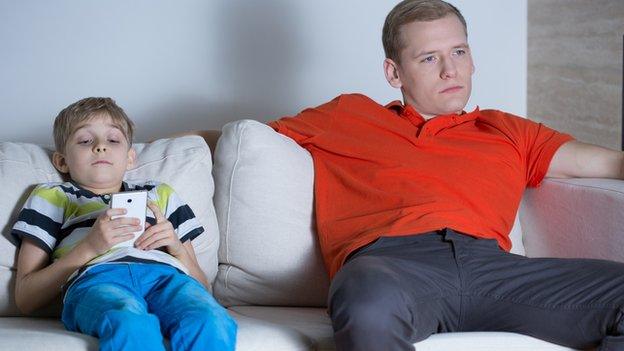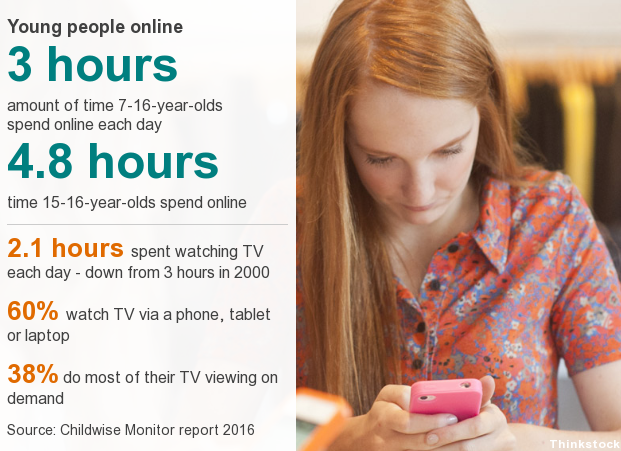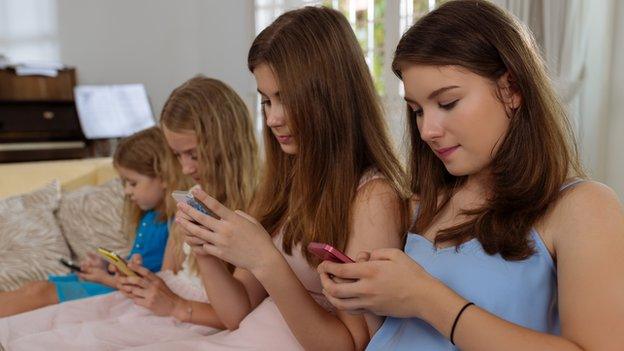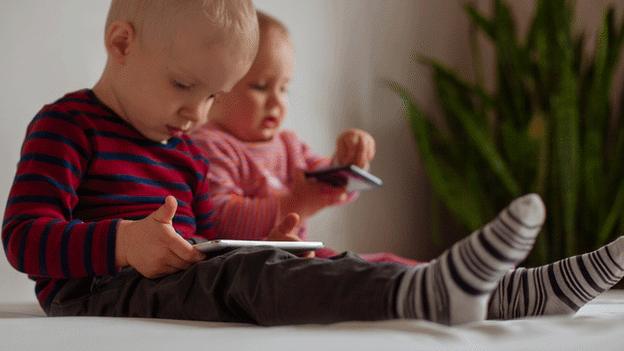Time spent online 'overtakes TV' among youngsters
- Published

Generation gap: Young people are switching off conventional television channels
Young people are spending more time playing and socialising online than watching television programmes, according to an annual survey tracking children's media behaviour in the UK.
Staff at research agency Childwise described it as a "landmark change".
Among those watching TV, the Netflix on-demand service was more popular than any conventional television channel.
There was also a surge in children's ownership of tablet computers, up by 50% compared with last year.
The annual media monitoring report, based on a sample of more than 2,000 five to 16-year-olds, has been following children's viewing behaviour since the mid-1990s.
On demand
This year's findings from Childwise are being claimed as a tipping point with children switching from conventional television to spending time online.
The average time spent online is now three hours per day, compared with 2.1 hours watching television.
Young people online
3 hours
amount of time 7-16-year-olds spend online each day
4.8 hours
time 15-16-year-olds spend online
-
2.1 hours spent watching TV each day - down from 3 hours in 2000
-
60% watch TV via a phone, tablet or laptop
-
38% do most of their TV viewing on demand

Among older teenagers in the survey there is an even more pronounced switch away from television, particularly at the time when it is broadcast.
Among 15 to 16-year-olds, less than a quarter would typically watch television as it is broadcast, rather than on a catch-up or on-demand service or through YouTube.
Among this age group, 32% had no favourite television programme.
And across the whole age range, none of the programmes identified as favourites, such as Hollyoaks and Pretty Little Liars, had been seen by more than 2% of young people in the previous week.
Boys had a preference for sport, such as Match of the Day, while girls preferred reality shows like Made in Chelsea.
Rise of tablets
Among television services, Netflix emerged as the most popular choice - overtaking all the conventional channels.
Asked about their viewing in the previous week, 50% had watched programmes on Netflix, compared with 47% for ITV1 and 46% for BBC1, the most popular television channels.
Young people still showed a clear preference for watching television on a television set - with only a relatively limited number watching programmes on mobile phones.

Mobile phones are the most typical way of using the internet
The study shows how much young people's lives are immersed in online activity and computer devices and how these forms of media are overlapping.
While the average time for online consumption is three hours per day, among 15 to 16-year-olds it rises to almost five hours.
The most common way of accessing the internet is the mobile phone, which is described as "near universal" among young people.
But particularly among younger children, there has been a sharp rise in access to tablet computers, now owned by 67% of youngsters, with the iPad by far the most widespread.
For the first time, tablet computers have overtaken other types of computer, such as laptops or desktops.
Children go online to watch videos, listen to music, play games and research their homework - and older children use it for social networking, particularly among girls.
The study reveals that however young people are accessing the internet, YouTube is the dominant destination.
The video-sharing website is used every day by almost half of all five to 16-year-olds, most often through a mobile phone or tablet, to watch video clips, listen to music and use games-related material.
They particularly want to see "funny" content on YouTube, but about a third watch "how-to" videos, including how to play computer games.
YouTube is also a popular way of watching television programmes, used by 74% of young people, compared with about 40% of this age group who watch programmes through the BBC iPlayer, which is the most popular of the broadcasters' on-demand services.
End of the CD player
Apart from YouTube, other popular online destinations are Snapchat, Instagram, Minecraft and Facebook.
The study also suggests the technologies that are disappearing. A shrinking number of young people listen to music via a CD player, with mobile phones now the leading medium.
It also warns that printed magazines are losing their appeal, with diminishing numbers of regular readers.
Simon Leggett, Childwise research director, said that this year's survey showed that "TV viewing has been redefined".
"Growing access to the internet at any time and in any place, and a blurring of television content across channels and devices, brings a landmark change in behaviour this year.
"Children are now seeking out the content of their choice. They still find traditional TV programmes engaging but are increasingly watching them online and on-demand or binge watching box sets."
- Published27 March 2015

- Published10 January 2012
